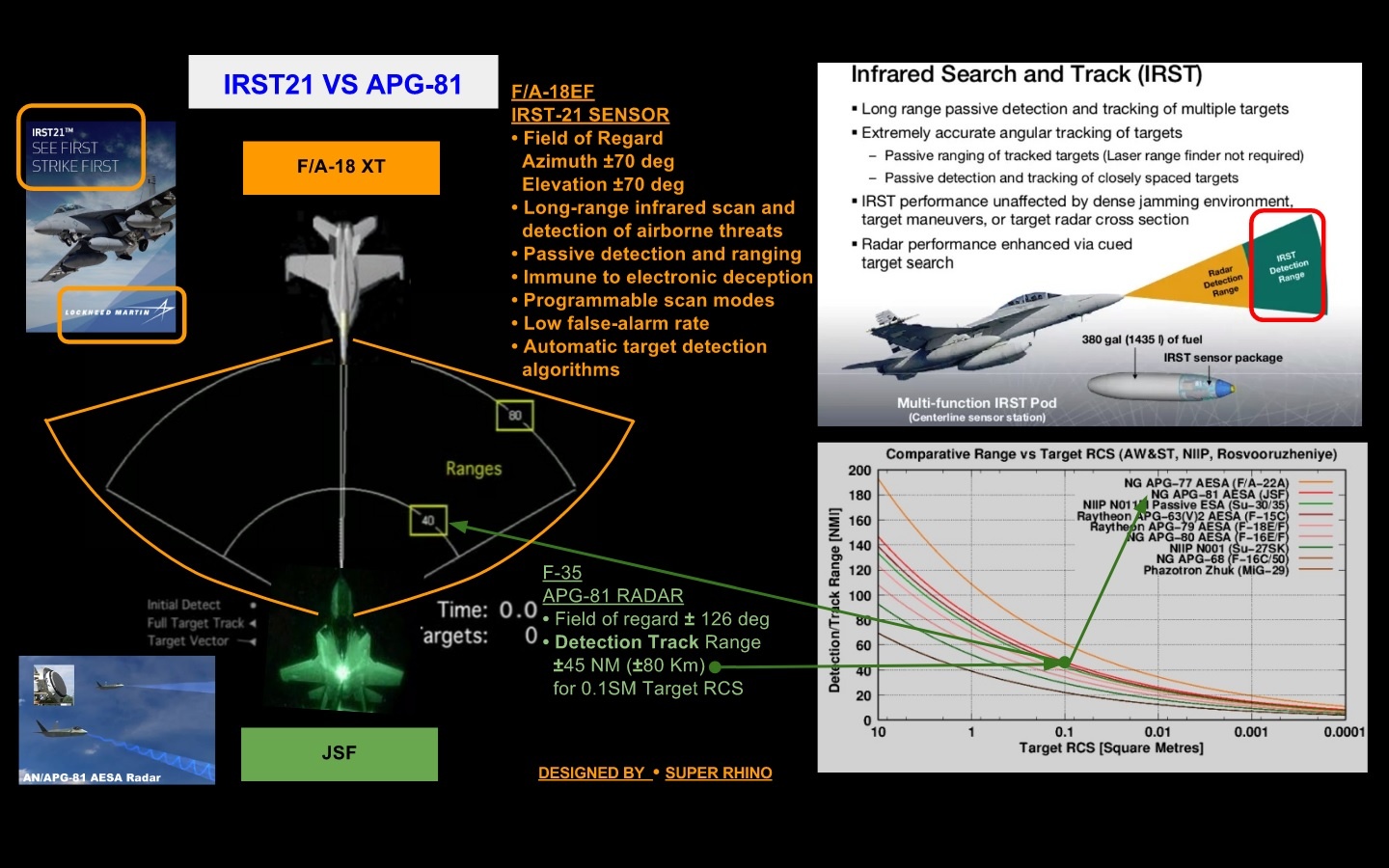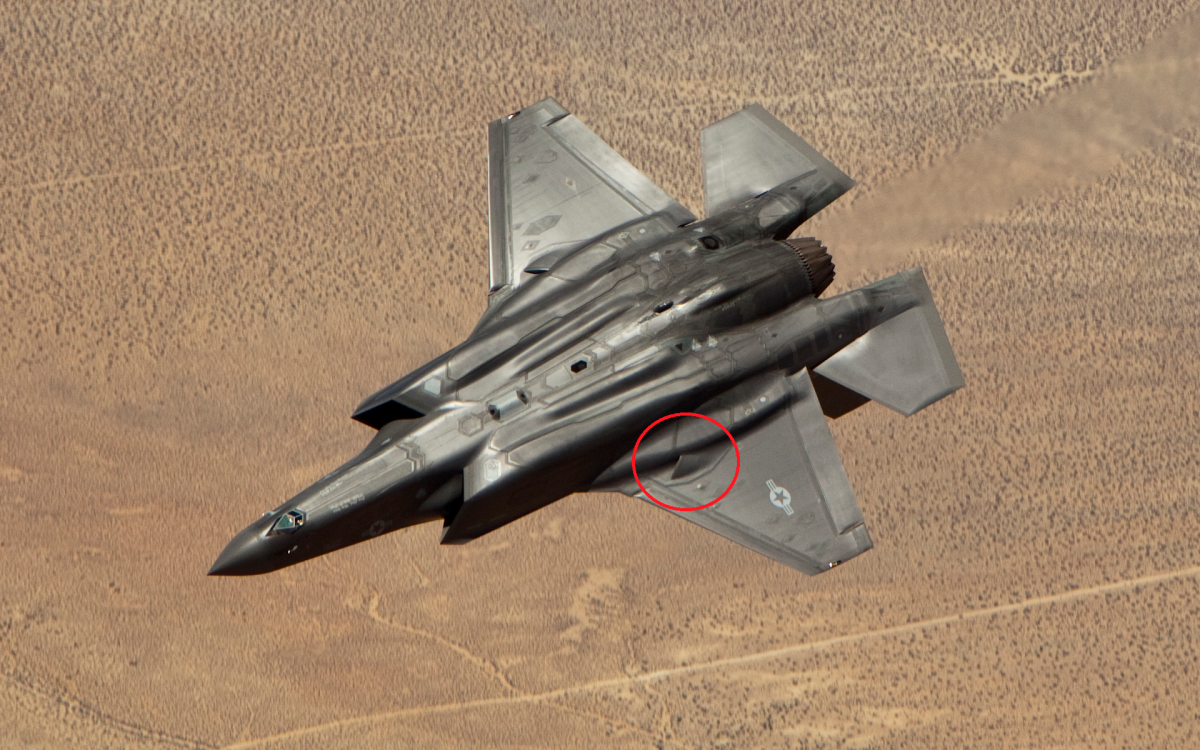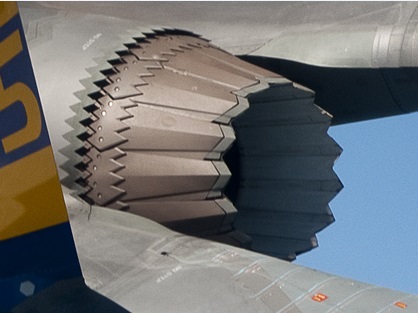F-35 vs F/A-18 XT
- Active Member

- Posts: 210
- Joined: 02 Jun 2016, 19:51
- Location: Ireland
Seeing as the basement dweller thread is locked I thought I would share this image of where an IRST hanging from the belly of a Super Hornet can vastly out-detect the worlds most advanced jet fighter
Will the world tremble in fear from an IRST glued to the front of an external fuel tank?

(courtesy of one of the minions on Solomon's safe space)
Will the world tremble in fear from an IRST glued to the front of an external fuel tank?

(courtesy of one of the minions on Solomon's safe space)
- 0.1m^2 is the low-end estimate for the Rhino's clean RCS.
- The Air Power Australia APG-81 data is based on the assumption that the F-35 has 1200 T/R modules (instead of its actual 1628) and that each APG-81 T/R module has a lower output power than the APG-77.
- APA's source on the APG-77 is Aviation Week, who also said that the APG-77v1, which would use tech from the APG-81, would have roughly double the range of the original.
- The IRST detection range being greater than radar detection range figure is obviously going to be against low-RCS targets.
- Elite 5K

- Posts: 5298
- Joined: 13 Mar 2013, 08:31
- Location: Finland
Yeah, like EOTS which is similar to IRST21, atlhough it might well have superior performance. AFAIK, IRST21 uses LWIR (long wavelength IR) whereas EOTS is MWIR (medium wavelength IR). MWIR systems outperform LWIR systems in most tactical situations but are more expensive. Of course F-35 also has full sensor fusion between all sensors within flight of F-35s whereas F/A-18 has currently none and might have basic sensor fusion in the future.
- Forum Veteran

- Posts: 706
- Joined: 16 Jul 2015, 02:49
hornetfinn wrote:Yeah, like EOTS which is similar to IRST21, atlhough it might well have superior performance. AFAIK, IRST21 uses LWIR (long wavelength IR) whereas EOTS is MWIR (medium wavelength IR). MWIR systems outperform LWIR systems in most tactical situations but are more expensive. Of course F-35 also has full sensor fusion between all sensors within flight of F-35s whereas F/A-18 has currently none and might have basic sensor fusion in the future.
And what about when DIRM comes on Line? what do you think the range will be for a dazzling laser? Your looking through a straw for stealth fighters, when suddenly your irst, is blinded. An AMRAAM will follow assuming you are not dead by then.
- Forum Veteran

- Posts: 850
- Joined: 15 Oct 2009, 18:43
- Location: Australia
bojack_horseman wrote:Seeing as the basement dweller thread is locked I thought I would share this image of where an IRST hanging from the belly of a Super Hornet can vastly out-detect the worlds most advanced jet fighter
Will the world tremble in fear from an IRST glued to the front of an external fuel tank?
(courtesy of one of the minions on Solomon's safe space)
Hahahaha....good luck with using that IRST in cloudy or rainy weather (if the IRST is your only saviour)!
The cretin who made that terrible/half arsed comparison must have forgotten about the F35's EOTS/IRST, EODAS, advanced EW systems, multiple off board data sources (at high bandwidth/network speeds whenever possible) and the superb APG 81 radar (clearly underestimated by this cretin).........all the data (all sensor and off board data) fused together to produce one coherent and succinct common operating picture.......which thrashes whatever information one IRST can produce.
This terrible comparison was produced by Super Rhino ehh......where have I seen this cretin before.....stuck in outdated 4th gen thinking.
Dragon029 wrote:
- 0.1m^2 is the low-end estimate for the Rhino's clean RCS.
- The Air Power Australia APG-81 data is based on the assumption that the F-35 has 1200 T/R modules (instead of its actual 1628) and that each APG-81 T/R module has a lower output power than the APG-77.
- APA's source on the APG-77 is Aviation Week, who also said that the APG-77v1, which would use tech from the APG-81, would have roughly double the range of the original.
- The IRST detection range being greater than radar detection range figure is obviously going to be against low-RCS targets.
Given your youtube video on radar, how do you suppose this would be possible? Could they really have made that much improvement in power output, gain, noise floor, etc. to get double the range? That sounds like an amazing accomplishment.
Supposedly the APG-77 (original) T/R modules put out 4W, with the APG-81 and APG-77v1 T/R modules putting out 10W; that doesn't mean twice the range (as per the equation and my video), but if (in addition) the minimum detectable signal (noise floor) was lowered by 4dB, or if noise floor went down by 3dB and gain improved by 1dB, or some other mix, you'd get the 1.6x theoretical max range improvement to go from 250km (150mi) to 400km (250mi).
I don't know how feasible that is; Hornetfinn would have a better idea, but those are roughly the numbers you'd need.
I don't know how feasible that is; Hornetfinn would have a better idea, but those are roughly the numbers you'd need.
- Elite 4K

- Posts: 4486
- Joined: 23 Oct 2008, 15:22
This is one of the more absurd graphics, that's ever been put together. I'm not sure in what fantasy world, an armed Super Hornet has a .1m^2 RCS. Secondly, the 45nm detection range for the APG-81 is laughable (much less being outsticked by the SH IRST,) and more laughable still, is the notion of detecting an F-35 at >90nm from the frontal aspect. Thirdly, it completely ignores the F-35's EOTS, which has at least equivalent if not superior capabilities to ATFLIR. Lastly, it completely ignores sensor fusion and third party data. I could go on, but I won't.
The FLIR pod is made by LM. Don't know who they think they are fooling.
Choose Crews
- Elite 1K

- Posts: 1102
- Joined: 25 Dec 2015, 12:43
1/ RCS of Superhornet with missiles and fuel tanks is much bigger than 0.1 m2, even the Gripen was advertised to have RCS around 0.4 m2 with only 4 AAM. With a centerline fuel tank the F-18 RCS would be at least 1 m2 if not much more
2/ Estimation of APG-81 radar range on APA was based on the assumption that it has only 1000-1200 T/R modules,

however, later modules count shown that it has around 1626 T/R modules

3/ Maximum detection range of IRST is always given in perfect condition such as high altitude, look up , target in tail on aspect. In reality when condition is less than perfect then the detection range will be reduced significantly. For example

4/ IRST on itself (without LRF) lack ability to measure target's velocity or altitude, so much more inferior to radar for long range missiles launch ( which rely on lead intercept ).LRF can do those things but has very short range and affected by weather too. Passive ranging relied on either triangulation between multiple aircraft or kinematic ranging.Given F-18 doesn't have directional datalink like MADL , datalink will likely reveal its general direction, kinematic ranging on the other hand would not require datalink but unless F-35 pilot completely unaware of F-18 and keeping a constant course (speed, direction, altitude), the result from kinematic ranging will be messed up easily.
5/ F-35 has various IR reduction feature that F-18XT lacks such as the Topcoat, cooling vents , serrated nozzle , hidden nozzle ..etc


6/ According to LM , advanced EOTS promises better performance “than any pod currently [fielded] or currently envisioned, while that is a subject to debate if we compare AEOTS against others manufacturer product, as LM own both AEOTS and IRST21, it is safe to conclude that AEOTS offer better performer.
2/ Estimation of APG-81 radar range on APA was based on the assumption that it has only 1000-1200 T/R modules,

however, later modules count shown that it has around 1626 T/R modules

3/ Maximum detection range of IRST is always given in perfect condition such as high altitude, look up , target in tail on aspect. In reality when condition is less than perfect then the detection range will be reduced significantly. For example

4/ IRST on itself (without LRF) lack ability to measure target's velocity or altitude, so much more inferior to radar for long range missiles launch ( which rely on lead intercept ).LRF can do those things but has very short range and affected by weather too. Passive ranging relied on either triangulation between multiple aircraft or kinematic ranging.Given F-18 doesn't have directional datalink like MADL , datalink will likely reveal its general direction, kinematic ranging on the other hand would not require datalink but unless F-35 pilot completely unaware of F-18 and keeping a constant course (speed, direction, altitude), the result from kinematic ranging will be messed up easily.
5/ F-35 has various IR reduction feature that F-18XT lacks such as the Topcoat, cooling vents , serrated nozzle , hidden nozzle ..etc


6/ According to LM , advanced EOTS promises better performance “than any pod currently [fielded] or currently envisioned, while that is a subject to debate if we compare AEOTS against others manufacturer product, as LM own both AEOTS and IRST21, it is safe to conclude that AEOTS offer better performer.
- Senior member

- Posts: 485
- Joined: 05 Aug 2015, 21:11
Assuming the F-35 and F/A-18XT meet up with each other at under 50 km and IRST has detected the JSF.
The F-35 can
-Getter better pK due to more sensor resolution,less missiles needed to kill target
-Fire at greater ranges since it's stealthy, the Super Hornet needs shorter ranges for AMRAAM seeker to get better pK
-Fire at greater ranges since assuming they will be both dodging missiles and reliant on seekers to fire and forget and the F-35 can guide 360 with DAS while it's evading missiles
-Having a kinematic advantage, since it can shoot and turn and guide with DAS, the Super Hornet's sensors only point in one direction
-Better acceleration
The F-35 can
-Getter better pK due to more sensor resolution,less missiles needed to kill target
-Fire at greater ranges since it's stealthy, the Super Hornet needs shorter ranges for AMRAAM seeker to get better pK
-Fire at greater ranges since assuming they will be both dodging missiles and reliant on seekers to fire and forget and the F-35 can guide 360 with DAS while it's evading missiles
-Having a kinematic advantage, since it can shoot and turn and guide with DAS, the Super Hornet's sensors only point in one direction
-Better acceleration
HUGE LOL! Since when does SH has a RCS of 0.1 square meters??
Not even in a clean configuration, this I'm willing to bet!
Last time I read a RCS value for the SH it was around 0.9 square meter, this if my memory doesn't fail me. This RCS for the SH could have been an "average" value (of several aspects of the aircraft towards the radar course) but guess what?? So is the 0.001 square meter value for the F-35!
Moreover that guy forgets (like other said here) that weather condition affects any IRST performance as well as the F-35 includes several measures to reduce the aircraft's IR signature (for example such as being able to carry cooled fuel).
Also that same guy forgets that IRST are also very limited in terms of giving accurate target range values.
Not even in a clean configuration, this I'm willing to bet!
Last time I read a RCS value for the SH it was around 0.9 square meter, this if my memory doesn't fail me. This RCS for the SH could have been an "average" value (of several aspects of the aircraft towards the radar course) but guess what?? So is the 0.001 square meter value for the F-35!
Moreover that guy forgets (like other said here) that weather condition affects any IRST performance as well as the F-35 includes several measures to reduce the aircraft's IR signature (for example such as being able to carry cooled fuel).
Also that same guy forgets that IRST are also very limited in terms of giving accurate target range values.
“Active stealth” is what the ignorant nay sayers call EW and pretend like it’s new.
The 0.1m^2 comes from a Boeing or USN statement a while back, claiming that the Super Hornet's RCS was an order of magnitude smaller than the Hornet's. The Hornet's RCS is disputed, but I've seen it quoted as 1 or 3m^2.
Of course, "an order of magnitude" when it comes to marketing rarely means an exact 10x, so the general consensus is that the Super Hornet has an RCS between 1m^2 and 0.1m^2.
Edit: Also, when you consider the RAM usage (particularly in wing leading / trailing edges), use of radar blockers, sawtoothing & edge alignment of various panels, etc, it's not that hard to believe.
Of course, "an order of magnitude" when it comes to marketing rarely means an exact 10x, so the general consensus is that the Super Hornet has an RCS between 1m^2 and 0.1m^2.
Edit: Also, when you consider the RAM usage (particularly in wing leading / trailing edges), use of radar blockers, sawtoothing & edge alignment of various panels, etc, it's not that hard to believe.
Who is online
Users browsing this forum: No registered users and 9 guests
